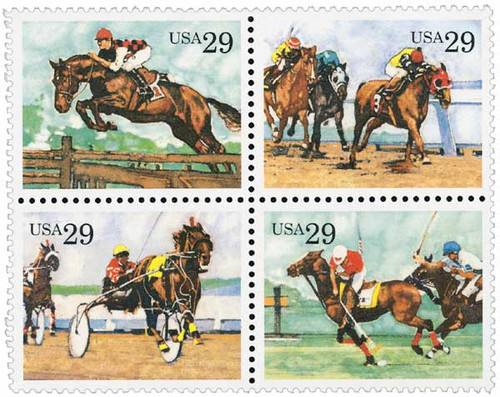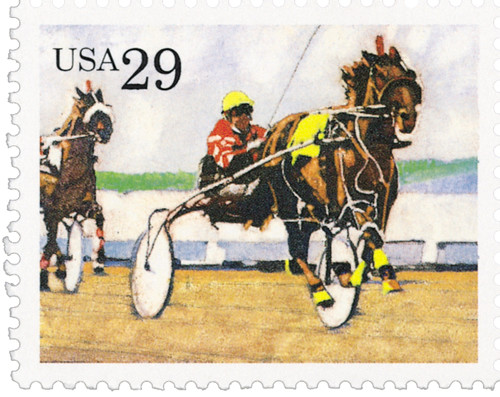
# 2759 FDC - 1993 29c Sporting Horses: Polo
U.S. #2759
1993 29¢ Polo
Sporting Horses
· Issued at the 110th running of the Kentucky Derby
· From the second block of four stamps to honor horses
Stamp Category: Commemorative
Set: Sporting Horses
Value: 29¢
First Day of Issue: May 1, 1993
First Day City: Louisville, Kentucky
Quantity Issued: 40,000,000
Printed by: Stamp Venturers
Printing Method: Lithographed, engraved
Format: Panes of 40 from plates of 160
Perforations: 11.1 x 11.5
Color: Multicolor with black intaglio
Why the stamp was issued: As a follow-up to the 1985 Horses block (US #2155-58), the Sporting Horses were issued at the 119th annual Kentucky Derby.
About the stamp design: Engraved by Yves Baril, the stamp features artwork from first-time US stamp designer Michael Dudash (who had previously worked on stamps for the UN). While the USPS chose not to specially feature famous horses in this set, the illustrations were based on photos from actual events.
Dudash didn’t identify the specific sources for his illustration on the polo stamp, simply saying it was it was a “conglomeration, created out of many, many sources.”
Special design details: There was a mistake in the selvage markings for the Sporting Horses sheet. The phrase “Use Correct Zip Code,” is incorrect – ZIP should be in all capital letters as its an acronym for “Zoning Improvement Plan.” There was also at least one pane of 40 stamps found without the black intaglio printing for “29¢” and “USA.”
First Day City: Issued at Churchill Downs, in Louisville, Kentucky, during the 119th annual running of the Kentucky Derby.
About the Sports Horses Stamps: The USPS referred to the block of four as “Horses II,” considering them a follow-up to the 1985 Horses block. Those weren’t the first US stamps to picture horses. A post horse and rider was included in the 1869 Pictorial Series (US #113). However, only two other stamps prior to this had pictured equestrian sports – a 1974 10 stamp honoring the 100th anniversary of the Kentucky Derby (US #1528) and a 1979 15¢ stamp showing an Olympic horse race (US #1794).
History the stamp represents:
Developed in Persia (present-day Iran) in 6 B.C., polo was originally a training game for the king’s elite cavalry units. As the game’s popularity increased, it became a Persian national sport played by both male and female members of the nobility.
From Persia, polo spread to Arabia, China, and Japan. Muslim conquerors brought the game to India during the 13th century. It was here that the sport was first played by Europeans. Seeing the game played by tribal horsemen, British cavalry officers tried it in 1862. Using eight payers to a team and almost no rules, the cavalry units held informal matches.
A popular pastime, polo was brought back to England. By 1875, matches at Richmond Park and Hurlingham were attracting more than 10,000 spectators. The following year, sportsman and journalist James Gordon Bennett introduced the game in the United States. Using a long-hitting, fast-moving style, U.S. players revolutionized the sport.
Today polo is played with two teams of four players. Using long-handled mallets to pass the ball, the players maneuver their way up the field and try to score by hitting their ball through opponents’ goal posts. Polo ponies (a traditional term since full-size horses are used) must have speed, endurance, and agility since they account for 60-75% of a player’s ability.
U.S. #2759
1993 29¢ Polo
Sporting Horses
· Issued at the 110th running of the Kentucky Derby
· From the second block of four stamps to honor horses
Stamp Category: Commemorative
Set: Sporting Horses
Value: 29¢
First Day of Issue: May 1, 1993
First Day City: Louisville, Kentucky
Quantity Issued: 40,000,000
Printed by: Stamp Venturers
Printing Method: Lithographed, engraved
Format: Panes of 40 from plates of 160
Perforations: 11.1 x 11.5
Color: Multicolor with black intaglio
Why the stamp was issued: As a follow-up to the 1985 Horses block (US #2155-58), the Sporting Horses were issued at the 119th annual Kentucky Derby.
About the stamp design: Engraved by Yves Baril, the stamp features artwork from first-time US stamp designer Michael Dudash (who had previously worked on stamps for the UN). While the USPS chose not to specially feature famous horses in this set, the illustrations were based on photos from actual events.
Dudash didn’t identify the specific sources for his illustration on the polo stamp, simply saying it was it was a “conglomeration, created out of many, many sources.”
Special design details: There was a mistake in the selvage markings for the Sporting Horses sheet. The phrase “Use Correct Zip Code,” is incorrect – ZIP should be in all capital letters as its an acronym for “Zoning Improvement Plan.” There was also at least one pane of 40 stamps found without the black intaglio printing for “29¢” and “USA.”
First Day City: Issued at Churchill Downs, in Louisville, Kentucky, during the 119th annual running of the Kentucky Derby.
About the Sports Horses Stamps: The USPS referred to the block of four as “Horses II,” considering them a follow-up to the 1985 Horses block. Those weren’t the first US stamps to picture horses. A post horse and rider was included in the 1869 Pictorial Series (US #113). However, only two other stamps prior to this had pictured equestrian sports – a 1974 10 stamp honoring the 100th anniversary of the Kentucky Derby (US #1528) and a 1979 15¢ stamp showing an Olympic horse race (US #1794).
History the stamp represents:
Developed in Persia (present-day Iran) in 6 B.C., polo was originally a training game for the king’s elite cavalry units. As the game’s popularity increased, it became a Persian national sport played by both male and female members of the nobility.
From Persia, polo spread to Arabia, China, and Japan. Muslim conquerors brought the game to India during the 13th century. It was here that the sport was first played by Europeans. Seeing the game played by tribal horsemen, British cavalry officers tried it in 1862. Using eight payers to a team and almost no rules, the cavalry units held informal matches.
A popular pastime, polo was brought back to England. By 1875, matches at Richmond Park and Hurlingham were attracting more than 10,000 spectators. The following year, sportsman and journalist James Gordon Bennett introduced the game in the United States. Using a long-hitting, fast-moving style, U.S. players revolutionized the sport.
Today polo is played with two teams of four players. Using long-handled mallets to pass the ball, the players maneuver their way up the field and try to score by hitting their ball through opponents’ goal posts. Polo ponies (a traditional term since full-size horses are used) must have speed, endurance, and agility since they account for 60-75% of a player’s ability.










